Potentiometer Definition:
“A potentiometer is an electrical device that changes the resistance value to control the flow of current and also measures emf of a cell.”
A potentiometer, also known as ‘pot‘ is a passive and three-terminal device. Though pot and variable resistors (rheostats) seem to be the same device, they differ in their connections within a circuit. It is an electrical device rather an electronic device.
What does a potentiometer do?
A pot limits the current flow by providing resistance value. That means it can increase or decrease the current of a circuit. It also works as an adjustable voltage divider. Based on this functionality, a pot can measure the electrical emf also.
Examples: 1k resistor potentiometer, 10k potentiometer& 100k potentiometer
The ‘k’ represents kiloohms. The numeric value tells the value of resistance. 1k means that the pot will provide resistance up to 1000 ohm. 10k & 100k means it will provide ten times and 100 times more resistance than 1k, respectively. The lesser the resistance value, the more the current drawn by that pot. Similarly, a 500k pot means it has a resistance value between 0 to 500 kiloohm.
How does the potentiometer work?
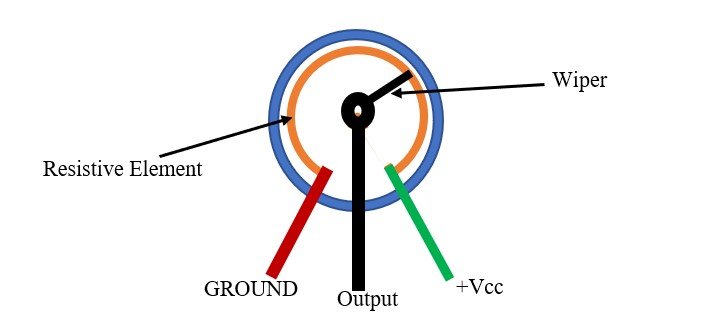
Potentiometers have some basic working principles. A pot has two terminals as input (marked as red and green in the figure). The input voltage is applied – across the resistor. Then the output voltage is measured. It comes out as the difference between the fixed and moving contact. The wiper plays a vital role here. While optimizing the output voltage- as per the need, the wiper needs to be moved- along the resistive element. Moving the slider helps to balance the galvanometer in case of measuring the emf of a cell. Now it acts as a voltage divider as it continuously produces variable voltage. Based on this concept, a pot measures electrical emf.
How does a potentiometer work as a voltage divider?
When the pot’s slider is moved- to the right, that causes a fall in resistance, fall in resistance further causes a small voltage drop. After that, if the wiper is moved- to the left, the resistance value eventually gets increased. Noe, there is also a voltage drop, but this time it is more than the previous case. So we can conclude that the output voltage has a direct relationship with the position of the wiper. The voltage drop value is calculated -by subtracting from the source voltage.
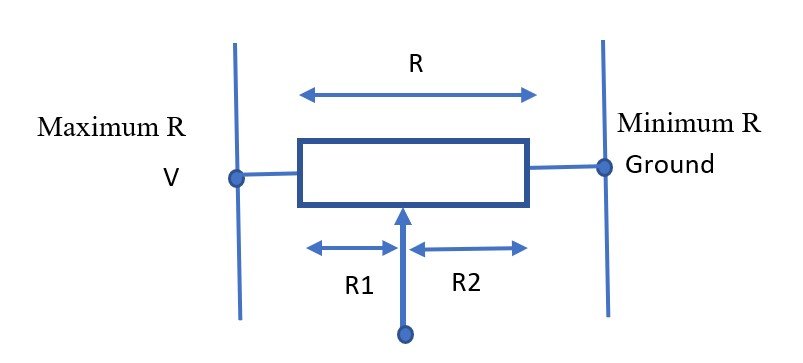
Types of Potentiometers
Based on shape, there are mainly two types
They are –
- A. Linear pot.
- B. Rotary pot.
Linear potentiometer:
In this type of pot, the slider moves linearly. Some different types are –
Slider potentiometer or slide pot:
If the wiper moves, in left-right or up-down direction, to adjust the pot, then it is slide pot. Slide pots find its application in audio, where it is known as faders.
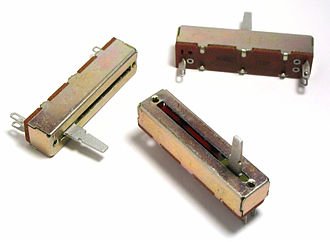
Dual slide pot:
If a single slider controls two pots at a time, then it is a dual-slide pot. It also finds application in audio controlling.
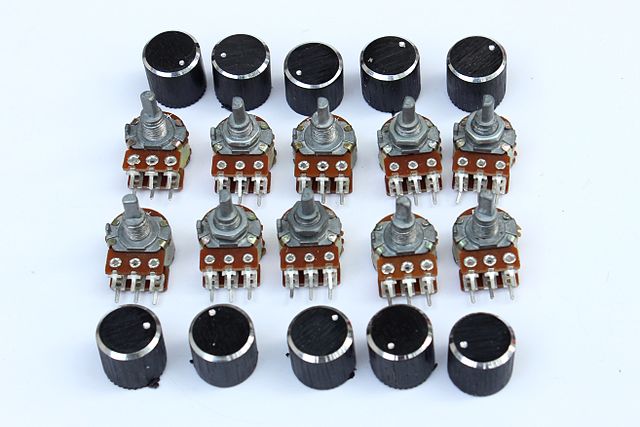
Motorized slide pot
If a servo motor controls a slide pot’s slider, the pot is called a motorized slide pot or motorized fader. It has applications in audio control, where automatic control is required.
B. Rotary Pot
In this type of pot, the slider moves circularly. Some different types are –
Single – turn pot:
In a rotary pot, if it takes a single turn to control the pot, this type of rotary pot is known as a single turn pot. It takes approximately 3π / 2 degrees.

Multi-turn pot:
This type of pot requires multiple rotations of the slider. It generally takes 5-6 turns. It provides high precision and controls, that is why it has application in calibration circuits.
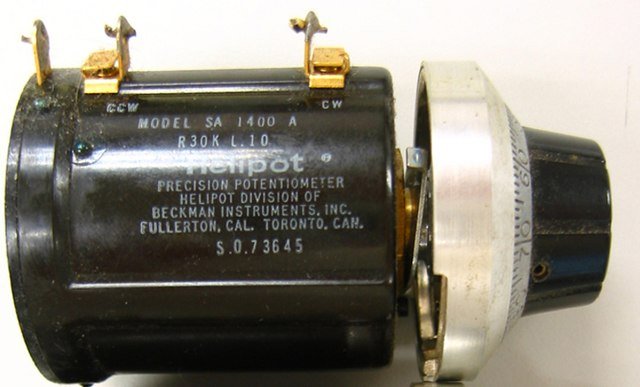
Symbol of the potentiometer?
The symbol of a pot is a standard resistor symbol with an arrow. Note that a variable resistor or rheostat symbol is also a resistance symbol with an added arrow, but the arrow’s position differentiates the devices.


Difference between rheostat and a potentiometer?
There is a misconception that a rheostat and a potentiometer are the same things, but there are some differences. Let us discuss some of them –
| Subject of Comparison | Potentiometer | Rheostat |
| Number of Terminals | Three terminal device | Two terminal device |
| Connection in Circuit | Parallel connection | Series connection |
| Quantity Controlled | Controls Voltage | Controls Current |
| Application | Low power application | High power application |
| Number of Turns | Both single and multi-turn | Single turn |
| Resistive material | Materials like Graphite | Carbon disk, Constantan, Platinum, etc |
| Symbol |  |  |
Frequently asked questions
1. What is the resistive element composed of a potentiometer?
The resistive element is the cause that a pot can offer resistance. Generally, Graphite is the material for making resistive elements. Sometimes they are also made of carbon materials, resistive wires, ceramic metal mixtures, etc.
2. What is a digital potentiometer?
A digital pot is a digital device. It performs the same task as an analog pot does. It has found application in microcontroller electronics.
3. What is a logarithmic potentiometer?
A logarithmic pot changes its resistance value logarithmically. It comes under the non-linear type.
4. What are the parts of a potentiometer?
A typical pot consists of – two fixed terminals and a moving terminal. It also has a resistive element. By using the two fixed terminals, potentiometers take the input. The other part is a wiper or slider.
5. Does a potentiometer reduce voltage?
No, a pot doesn’t change the voltage of the circuit. It only controls resistance.
6. What is a potentiometer knob?
A pot knob is a holder for the slider of a rotary pot. By rotating the knob, the resistance changes.
7. How to compare – the emf of two cells using a pot?
EMF or electromotive-force is a parameter of measuring energy. It is the reason behind the flow of current in a circuit. The potential difference between two points is referred- to as electromotive-force. Its unit is volt.
The mathematical formula is – e = E / Q, where q is the charge, and E is the energy. By using a pot, we can find the emf of a cell. We need to find out the balancing length, where the galvanometer deflection is nearer to null. The potential fall along the length l is the measure of the emf. E is proportional to l.
We can write,
E ∝ l
or, E = K * l , K =Constant
or, E / l = k ———- (i)
Now relation of E1 and l1 with E2 and l2 can be written using equation (i) –
E1 = k * l1
or, E1 / l1 = k ——— (ii)
E2 = k * l2
or, E2 / l2 = k ———(iii)
From (ii) and (iii) we can write –
E1 / l1 = E2 /l2 = k
or, E1 / l1 = E2 / l2
8. A cell with internal resistance 1 ohm and emf 5 volts balances on a potentiometer wire at a length of 1.25 meters. The driving cell has an emf of 50 volts. If a 1-ohm wire connects the balance point and the battery, then the balance point will shift.
(Assuming that balancing length is measured from the higher potential side of pot wire.)
- A. 1.25 meters towards the right
- B. 1.25 meters towards the left
- C. 2.5 meters towards the left
- D. None of the above
At first, the balanced length is 1.25 m. Let’s consider it as l1.
Now a wire of 1-ohm resistance connects the balance point and the cell.
We know that E = k * l
Here, l = l1 and E = 5v
k * l1 = 5 – (i)
Now the current through resistance is = (5/2) A = 2.5 A
By adding up the resistance of 1 ohm, the equivalent resistance comes as = 1+1 = 2 ohm.
Hence the E value for the later case becomes 2.5 v.
k * l2 = 2.5 – (ii)
We know that –
E1/E2 = l2/l1
from equations (i) and (ii), we find out –
5/2.5 = l2/l1
putting l1 in the equation,
l2 = 0.5 * l1
or, l2 = 0.5 * 1.25
or, l2 = 0.625 m
So, the balance point shifts 0.625m towards the left.
The correct answer is the option – D. None of the above.
9. A potentiometer is better than a voltmeter for measuring emf of a cell. Why?
When we balance a cell against a pot wire, There is no current through the cell. The emf is measured then. Now, when we use a voltmeter to measure the emf for the cell, there is a small current which flows through the cell. Thus, we get only the terminal potential.
10. How can you increase the accuracy of the potentiometer?
The accuracy of a pot can be increased by maximizing the length of the wire up to a certain limit.

Hi, I am Sudipta Roy. I have done B. Tech in Electronics. I am an electronics enthusiast and am currently devoted to the field of Electronics and Communications. I have a keen interest in exploring modern technologies such as AI & Machine Learning. My writings are devoted to providing accurate and updated data to all learners. Helping someone in gaining knowledge gives me immense pleasure.
Let’s connect through LinkedIn –